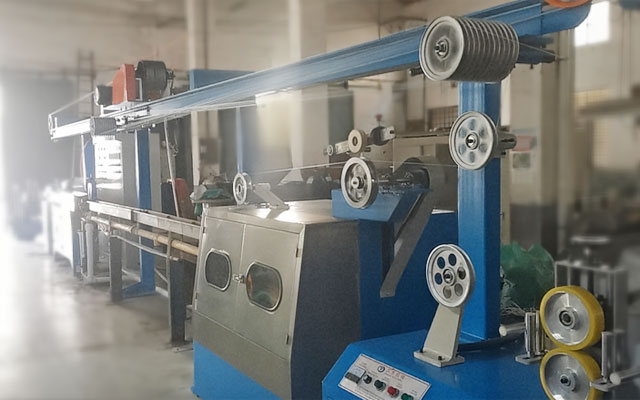Model 30-90Screw Diameter φ30-90 mmL/D Ratio 26:1/25:1Extrusion Output 25-250 kg/hMain Motor 18-63 KWOutlet Diameter 0.2-35 mmSpeed 10-600 m/minApplication Fishing and aquaculture rope
Fishing and Aquaculture Rope Extrusion Line
A fishing and aquaculture rope extrusion production line is a specialized industrial system designed for manufacturing plastic ropes and twines, or for applying a protective polymer coating to fiber or wire cores. Its core process involves melting polymer materials (mainly Polyethylene PE, Polypropylene PP, or Nylon PA) and continuously extruding them through a die to form ropes with specific diameters and structures, or to coat existing cores.
This production line creates the essential "tools" for the fishing and aquaculture industries. The ropes produced possess properties such as high strength, flexibility, abrasion resistance, and corrosion resistance, meeting the demanding requirements of the marine environment.
Main Characteristics of the Production Line:High Efficiency Continuous Production: Integrates feeding, extrusion, cooling, stretching, and winding into a fully automated continuous process.
Strong Customizability: By changing the die and process parameters, ropes of different diameters (from thin twines to thick hawsers), structures (e.g., monofilament, multifilament, braided), and colors can be produced.
Excellent Product Performance: The produced ropes have uniform texture, high strength-to-weight ratio, and good weather resistance.
Core Components of the Production Line
A complete fishing and aquaculture rope extrusion production line mainly consists of the following parts:
Extrusion SystemFunction: The core of the line, responsible for plasticizing, melting, and pressurizing the polymer pellets.
Composition:
Extruder: Includes a hopper, barrel, screw, heater, and cooling fan. The screw design is crucial for melting efficiency and stability.
Die (Mold): Determines the initial shape of the rope, such as circular for monofilament or multi-hole for multifilament yarn.
Cooling SystemFunction: To rapidly cool and solidify the extruded molten plastic rope.
Composition: Primarily a cooling water tank. The length and water temperature of the tank are critical for setting the rope's crystal structure and preventing adhesion.
Stretching SystemFunction: To stretch the cooled rope molecularly orienting it, significantly enhancing its tensile strength and stiffness.
Composition: Consists of multiple sets of rollers running at different speeds. Typically, two or more sets of stretching godet wheels are used to provide the necessary drawing ratio.
Annealing (Heat Setting) SystemFunction: To relieve internal stresses generated during stretching, reduce shrinkage, and stabilize the rope's dimensions.
Composition: Usually an annealing oven or hot water tank that provides controlled heating.
Winding SystemFunction: To wind the finished rope or twine onto spools or bobbins in an orderly manner.
Composition: Automatic winders equipped with traversing mechanisms and tension control devices to ensure uniform and tight winding.
(For Coating Lines, the composition is similar to the wire rope extrusion line described earlier, including pay-off, preheating, extruder, crosshead die, cooling, traction, and take-up systems.)
Fishing and Aquaculture Rope Extrusion Line Datasheet
| Model |
30 |
40 |
50 |
60 |
70 |
80 |
90 |
| Screw Diameter (mm) |
φ30 |
φ40 |
φ50 |
φ60 |
φ70 |
φ80 |
φ90 |
| Screw L/D Ratio |
25:1 |
25:1 |
26:1 |
26:1 |
26:1 |
26:1 |
26:1 |
| Extrusion Amount (kg/hr) |
25 |
40 |
70 |
100 |
140 |
200 |
250 |
| Outlet Wire (mm) |
0.2-1 |
0.4-3 |
0.8-5 |
1-8 |
2-15 |
3-25 |
5-35 |
| Total Power (KW) |
18 |
20 |
25 |
33 |
40 |
55 |
63 |
| Traction Power (KW) |
2.2 |
2.2 |
4 |
4 |
4 |
5.5 |
5.5 |
| Production Speed (m/min (Max.)) |
600 |
600 |
600 |
500 |
500 |
300 |
300 |
| Take-up Spool (mm) |
φ200-400 |
φ300-500 |
φ400-630 |
φ400-630 |
φ500-630 |
φ800-1000 |
φ1000-1250 |
Fishing and Aquaculture Rope Extrusion Line Application
The ropes produced by this line are indispensable in modern fishing and aquaculture, with wide-ranging applications:
Fishing NetsApplication: Used as the base material for manufacturing or repairing various fishing nets, trawls, and cages.
Advantage: The ropes are strong, durable, and resistant to seawater corrosion, ensuring the service life and safety of fishing gear.
Aquaculture Cages and LonglinesApplication: Used to construct and anchor marine aquaculture cages, as well as for suspension lines in longline culture (e.g., for kelp, scallops, oysters).
Advantage: Good weather resistance and fatigue resistance can withstand long-term exposure to wind, waves, and currents. Plastic ropes are also buoyant.
Fishing Vessel Mooring and TractionApplication: Used as mooring lines for fishing boats and trawler warps for towing nets.
Advantage: High strength, abrasion resistance, and flexibility meet the high-load demands of vessel operations.
Other ApplicationsApplication: Includes binding ropes, temporary fencing in aquaculture zones, and marker buoys.
Advantage: Can be customized in color and diameter for easy identification and management. The production process allows for high efficiency and consistent quality.


